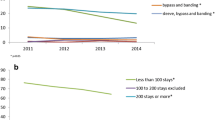Abstract
Background
This study aimed to examine hospital volume in New York state as a predictor of complications over 13 years.
Methods
Data from the New York state Statewide Planning and Research Cooperative Systems database were analyzed by diagnosis-related group, patient demographics, and outcomes. The institution data were analyzed on the basis of volume and logistic regression using chi-square analysis for predicting morbidity and mortality.
Results
From 1991 to 2003, 24,534 patients underwent bariatric surgery at 79 institutions. Case volume increased 36-fold in high-volume centers (HVCs), whereas the overall number of institutions doubled. The average mortality rate was 1.1% in low-volume centers (LVCs), 0.4% in medium-volume centers (MVCs), and 0.2% in HVCs. Whereas 12.4% of the LVC patients had postoperative anastomotic complications (PACs), only 9.7% had PACs in MVCs and only 7.3% had PACs in HVCs (p < 0.05). Furthermore, only 0.7% of the patients required postoperative reintubation (PRI) after surgery at HVCs, as compared with 1.5% at MVCs and 1.8% at LVCs (p < 0.05). Finally, 1.8% of the patients required blood transfusion of packed red blood cells at HVCs, whereas 2.4% required transfusion at MVCs and LVCs.
Conclusions
Experience correlates with fewer postoperative complications, including death, in bariatric centers in New York state.




Similar content being viewed by others
References
Betsy Lehman Center for Patient Safety and Medical Error Reduction (2004, August 4) Expert panel on weight loss surgery. Massachusetts Department of Public Health, Boston
Prevalence of Overweight and Obesity Among Adults: United States, 1999–2002. Retrieved on 6/2/06 at http://nchs/products/pubs/pubd/hestats/obese/obse99.htm/
Courcoulas A, Schuchert M, Gatti G, Luketich J (2003) The relationship of surgeon and hospital volume to outcome after gastric bypass surgery in Pennsylvania: a 3-year summary. Surgery 134: 613–621
DeMaria EJ, Sugerman HJ, Kellum JM, Meador JG, Wolfe LG (2002) Results of 281 consecutive total laparoscopic Roux-en-Y gastric bypasses to treat morbid obesity. Ann Surg 235: 640–647
Flegal KM, Carroll MD, Ogden CL, Johnson CL (2002) Prevalence and trends in obesity among U.S. adults, 1999–2000. JAMA 288: 1723–1727
Khuri SF, Daley J, Henderson W, Hur K, Hossain M, Soybel D, Kizer KW, Aust JB, Bell RH Jr., Chong V, Demakis J, Fabri PJ, Gibbs JD, Grover F, Hammermeister K, McDonald G, Passaro E Jr., Phillips L, Scamman F, Spencer J, Stremple JF (1999) Relation of surgical volume to outcome in eight common operations: results from the VA National Surgical Quality Improvement Program. Ann Surg 230: 414–429
Liu JH, Zingmond D, Etzioni DA, O'Connell JB, Maggard MA, Livingston EH, Liu CD, Ko CY (2003) Characterizing the performance and outcomes of obesity surgery in California. Am Surg 69: 823–828
Nagle AP, Prystowsky JB (2004) Surgical management of obesity. Clin Obset Gynecol 47: 928–941
Nguyen NT, Goldman C, Rosenquist CJ, Arango A, Cole CJ, Lee SJ, Wolfe BM (2001) Laparoscopic versus open gastric bypass: a randomized study of outcome, quality of life, and costs. Ann Surg 234: 279–291
Nguyen NT, Lee SL, Goldman C, Fleming N, Arango A, McFall R, Wolfe BM (2001) Comparison of pulmonary function and postoperative pain after laparoscopic versus open gastric bypass: a randomized trial. J Am Coll Surg 192: 469–476
Nguyen NT, Paya M, Stevens CM, Mavandadi S, Zainabadi K, Wilson SE (2004) The relationship between hospital volume and outcome in bariatric surgery at academic medical centers. Ann Surg 240: 586–594
Nguyen NT, Root J, Zainabadi K, Sabio A, Chalifoux S, Stevens CM, Mavandadi S, Longoria M, Wilson SE (2005) Accelerated growth of bariatric surgery with the introduction of minimally invasive surgery. Arch Surg 140: 1198–1202
Pope GD, Birkmeyer JD, Finlayson SR (2002) National trends in utilization and in-hospital outcomes of bariatric surgery. J Gastrointest Surg 6: 855–861
Schauer PR, Ikramuddin S, Hamad G, Gourash W (2003) The learning curve for laparoscopic Roux-en-Y gastric bypass in 100 cases. Surg Endosc 17: 212–215
Bariatric Surgery Center of Excellence Requirements. Retrieved 6/2/06 at http://www.surgicalreview.org/requirements.html
Author information
Authors and Affiliations
Corresponding author
Rights and permissions
About this article
Cite this article
Parker, M., Loewen, M., Sullivan, T. et al. Predictors of outcome after obesity surgery in New York state from 1991 to 2003. Surg Endosc 21, 1482–1486 (2007). https://doi.org/10.1007/s00464-007-9245-5
Received:
Revised:
Accepted:
Published:
Issue Date:
DOI: https://doi.org/10.1007/s00464-007-9245-5



